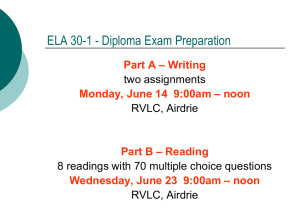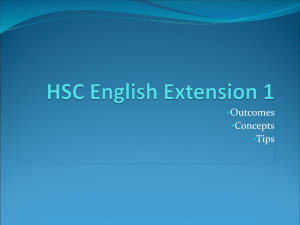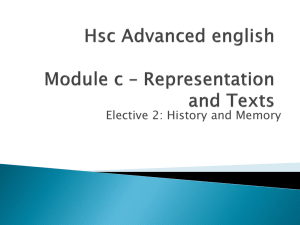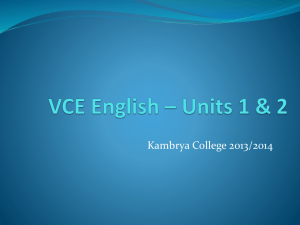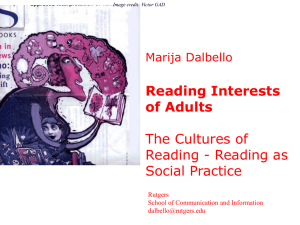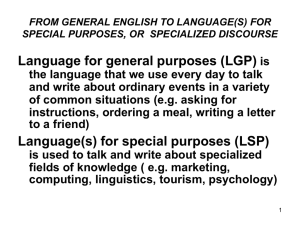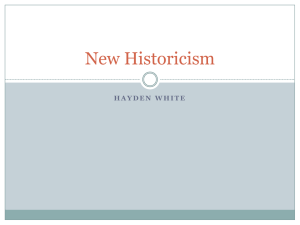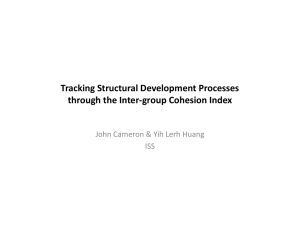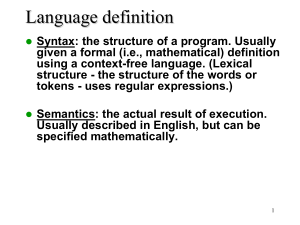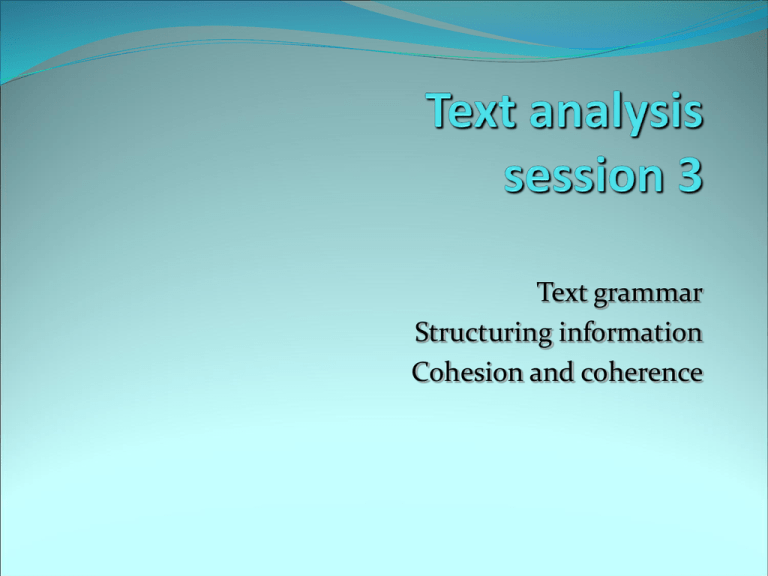
Text grammar
Structuring information
Cohesion and coherence
Quick revision
dimensions of variation
diaphasic: different communicative settings,
e.g.different levels of style/register, oral vs. written
diastratic: different social groups (according to age,
sex, profession ...), different sociolects e.g. young
people, hunters‘
Diatopic: different places and regions of the linguistic
area, different dialects e.g.Cockney English, Saxonian
German
diachronic: historical stages on the diachronic axis
e.g.extinct, obsolete, old-fashioned, current,
fashionable
Within a text
Different dimensions give variants. Variation can be
seen at a number of levels
Graphic
Phonological or graphological
Lexical
Grammatical
Discourse
Patterns of text organisation are grounded in the
details of the text.
Remember this?
A discourse analysis task
Look at the task in Worksheet 1 and the texts in Texts
2013
Text Analysis Similarities and differences.
Texts and their texture
• We looked at how certain language features run
through a text and help us to make sense of a text
• Now we will look at details of cohesion: overt
identifiable features, which you can learn to
recognise and name, which make up the texture of
a text and contribute to its unity
Cohesion
• _ "the way certain words or grammatical features of a
• sentence can connect that sentence to its predecessors
• (and successors) in a text." (Hoey 1991, 3)
• _ "The concept of cohesion is a semantic one; it refers
to relations of meaning that exist within the text, and
that define it as a text.” (Halliday and Hasan 1976, 4)
• _ Phonological cohesion
• _ Lexical cohesion
• _ Grammatical cohesion
Phonological cohesion
Grammatical cohesion: reference
• The idea of reference is that of having to look for the
full meaning somewhere else
• We can look for the information elsewhere in the text
(endophoric reference) or outside the text (exophoric
reference)
• The grammatical items refer to something or some one
and the reader automatically identifies what is being
referred to (the referent)
Exophoric reference
• First and second person pronouns
• The writer is being self-referential using I
• It is not always possible to identify exactly who we
refers to
• Many advertisements address the reader directly as
you and companies refer to themselves as we
• In television news demonstrative reference like this,
these, here often refer to elements outside the verbal
text but are visible in the visual part of the text.
Who exactly?
• We can be inclusive or exclusive
• It can include the audience (or readers) or it can refer to the
speaker/writer and some other people, to a nation or to a
small group of people
• “Now this is the scene right now in the
City, just a few miles from where I am
standing. We’ll bring you more on that in
a moment.”
• he wanted the big economies to be pumping
their own money into the system; we can’t
do that because we haven’t got any money
and that’s why his domestic political
standing is what it is.
Exophoric you
You can be specific, addressing the reader directly
(look at the advertisements and the gardening manual
for examples) or it can be generic
I think in my walk of life you get
attacks the entire time. That is part
of the business and you should not
complain about it normally. Indeed, if
you did, you would spend your entire
time complaining.
relationships
• Text
advertisement
• Real writer
• Implied reader
advertising copywriter
narrator
assumptions made in the text about
the persona
• Real reader
the real person
• Implied writer
Demonstrative reference
• The difference between the and a (definite and
indefinite articles, part of the demonstrative reference
system) are also a matter of different levels of
specificity and genericity
• Generic:
• The femur is the largest bone in the
body
• The family is a social institution
Cohesion - grammatical
• Reference:
• Remember Exophoric (refers outside the text to the
context)
• Endophoric (refers within the text)
• Anaphoric reference (referring back to an earlier part
of the text)
• Cataphoric reference (referring forwards to
something that comes later in the text
Tom said that he was going home.
I couldn’t believe it – the house had
been destroyed!
Grammatical Cohesion
• _ Anaphoric reference (e.g. Tom said that he was
going home)
• Used frequently, a normal part of text texture avoids
repetition and holds the text together
• _ Cataphoric reference (e.g.I couldn’t believe it – the
house had been destroyed!)
• Used less frequently. Used for particular effect, more
characteristic of literary texts, for example in building
suspense… or in news texts as an opening.
Anaphoric reference
• In many types of discourse we use the anaphorically to
refer to something which has already been introduced
by using a
• Once upon a time there was a king in a
foreign land who had a great desire to
marry. The king looked high and low in
the land but in vain
• Take a large pie dish and some peeled
and sliced apples; arrange the slices
in concentric circles in the dish
Comparison
• Comparative reference tells the reader to look
elsewhere with a particular aim in mind: to compare
the items that are being linked as sharing quantity or
quality
• Comparison involves ideas about quantity and number
using forms like more, fewer, less, another and quality
using expressions like such and so
Point of reference
• More cats prefer it
• The milder tobacco
• Kinder to the environment
• For a tastier meal
• Gets your clothes whiter
• We bake a better biscuit
Substitution
• Substitution means the writer has substituted one
item for another in a text. Often a long phrase is
substituted by a short word like one (to replace
nouns and noun phrases) do (to replace verbs and
verb phrases) or so or not (to replace whole
clauses). It avoids tedious repetition.
• If you are not sure about phrases and clauses look
at WWT Unit 3
Ellipsis
• Ellipsis involves omitting elements altogether. It is very
common in spoken language where participants know
they have shared knowledge and things do not need to
be made explicit. In some written texts ellipsis can
create an illusion of closeness between writer and
reader
• See Subaru text p 213 WWT
Conjunctions
• These are words which express how words, phrases
and sentences should be linked, whether the link is
temporal, additive, causal, continuative, alternative,
adversative etc.
• Different types of writing use different types of
conjunction so conjunctions often help to identify a
text type
Conjunction
Conjunction: refers to specific devices,
conjunctions which link sentences to each other.
Additive conjunctions add on information
Adversative conjunctions draw a contrast
Causal conjunctions make a causal link
Temporal conjunctions make a time link
between two sentences.
Spot the conjunctions
"If the neutrinos have broken the speed of light, then
it would overturn a keystone theory from the last
century of physics. That's possible, but it's far more
likely that there is an error in the data. So let me put
my money where my mouth is: if the Cern experiment
proves to be correct and neutrinos have broken the
speed of light, I will eat my boxer shorts on live TV.
Now I'd love it if neutrinos really have exceeded the
speed of light. But I'm not eating my shorts just yet.
Because my money is still on Einstein. He was, after
all, pretty smart. And I am not prepared to rewrite my
lecture course on relativity just yet.
Identify the kind of conjunction
If the neutrinos have broken the speed of light, then it
would overturn a keystone theory from the last
century of physics. That's possible, but it's far more
likely that there is an error in the data. So let me put
my money where my mouth is: if the Cern experiment
proves to be correct and neutrinos have broken the
speed of light, I will eat my boxer shorts on live TV.
Now I'd love it if neutrinos really have exceeded the
speed of light. But I'm not eating my shorts just yet.
Because my money is still on Einstein. He was, after
all, pretty smart. And I am not prepared to rewrite my
lecture course on relativity just yet.
Sort these conjunctions: additive,
contrastive, causal, or temporal?
• Finally, anyway, in addition, or, of course, furthermore,
the next day, in other words, yet, however, on the
contrary, so, then, for this reason, as a result, one day,
up to now, well, surely, but, after all, and, though,
consequently, now, likewise, it follows that, then
Lexical cohesion
the use of the same or similar or related words
in successive sentences, is of two types
Reiteration, where the same word is repeated.
Some writers try to avoid this by the use of
what is called elegant variation, this will
involve using such devices as
Synonyms
Superordinates
General words
Similarity or synonymy
It is rare to find a true synonym, there are usually
differences in style or association
Denotation is the dictionary definition of a word,
connotation means the associations a word carries,
the personal or emotional meanings that come from
the kinds of encounters we have had with the word
and the contexts we have found it in
Some words are found in particular text types or social
or regional varieties
Synonyms and varieties
Beautiful: Beauteous, bonny, comely, fair, dishy,
exquisite, handsome, resplendent, splendid,
splendiferous, gorgeous, lovely, picturesque, pretty,
pulchritudinous, ravishing, scenic, stunning
Good: great, groovy, keen, neat, nifty, smashing,,
acceptable, solid, superb, well-behaved
Fat: abdominous, chubby, plump,buxom, corpulent,
obese, weighty podgy, pudgy, tubby, fleshy, heavy,
overweight,gross, porcine, portly, stout
Lexical cohesion
Can involve other semantic relations between the
lexical items in the text.
For example contrast or antonymy
Hyponymy
Evaluation
Figurative tropes
Contrast or antonymy:
different kinds:
Complementarity: where the presence of one
excludes the other (e.g. dead/alive)
Converseness: where there is some kind of logical
reciprocity (e.g. husband/wife; buy/sell)
Incompatibility: words which are part of a set
(such as seasons, days of the week, colours)
Antonymy: all of the above but also gradable
opposites such as hot/cold, good/bad, big/small
Hyponymy
As we saw when we looked at lexical cohesion there are
also classification relationships such as subordination
e.g. animal /cat,
coordinates apple/banana; bicycle/motorbike
superordinates wheat/ cereal; vehicle/car
Hyponymy is where items are included in another
term, similar to the examples of sub and
superordination
Father is a hyponym of man
Woman is a hypernym of sister
Sets and fields
By field of discourse is meant the particular activity,
cultural feature, social institution or topic for which a
particular set of ideationally related lexical items is
evolved or adapted.
Each field has a specialised topic-related vocabulary
which makes up the lexical set
Sets and fields
By field of discourse is meant the particular activity,
cultural feature, social institution or topic for which a
particular set of ideationally related lexical items is
evolved or adapted.
Each field has a specialised topic-related vocabulary
which makes up the lexical set
Semantic features and fields
• _ Semantic features = components of meaning
• _ sea = body of water, saline, large
• _ Semantic fields = groups of words with shared
•
•
•
•
•
semantic features
_ sea
_ river
_ lake
_ stream
_ pond
Semantic field
Ways of looking:
Glare, wink, blink, stare, glance, gaze, scrutinize, look,
survey, overlook,
Use a dictionary to help you
What have they got in common? What kinds of
meanings distinguish them?
Ways of eating: gobble, slurp, chew, suck, swallow,
munch, crunch, nibble, savour, bite,
Ways of walking: scuttle, hobble, stride, limp, hop, skip,
amble,
Semantic field Example: Cookery
Artefacts etc.:
Pot, jug, kettle, pan, frying pan, saucepan, dish, jug,
bowl, ladle, carving-knife, fork, spoon, rolling pin,
breadboard, cooker, oven
Processes: boil, roast, bake, stew, simmer, poach, grill,
cut, dice, slice, chop, carve, peel, skin, mix, stir, beat,
whip, fold, strain
The field of cookery
Properties: tender/ tough (meat), fresh (fish, bread),
stale (bread), sour (milk, cream), light (pastry, cakes),
well-done, under-done, rare (steaks), hard-boiled, softboiled (eggs)
Phrases, collocations etc: boil over, off the boil, carve
a joint, bake bread, chop parsley, slice meat, bread,
tomatoes; spoon out, leave to set.
Semantic field Example: air travel
Artefacts etc. fuselage, landing-gear, wing, cockpit,
check-in, boarding-pass, lounge, gate, tickets, cabin,
airline, aircraft, crew, pilot, steward, route
Processes: take off, land, stack, taxi, check-in, book,
upgrade,
Properties: low cost, long-haul, short-haul, first-class,
business class, economy, domestic, intercontinental
Phrases, collocations: in mid-flight, air traffic
control, hand-luggage, cabin-luggage, air-miles, flight
attendant, cabin crew, (un)fasten your seatbelts, on
board
Nouns labelling technical features, artefacts, equipment,
structures etc
Verbs identifying and distinguishing between processes,
types of event methods etc.
Adjectives and adverbs indicating conventional
properties of the above
Phrases and conventional collocations that may expand,
modify or combine any of the above
Figurative extensions of the terms may be used outside
the field of discourse to general usage
Cohesion and coherence
• Cohesion is provided by overt lexical or grammatical
markers in the text
• Coherence is a term which is difficult to define but it is
concerned with our expectations and our knowledge of
the world and the way things fit together
Coherence
• Coherence is concerned with logical links which
mean that the text makes sense as a whole.
• Making sense:
• A. “That’s the phone!”
• B. “I’m in the bath!”
• A. “Ok”
• We try to find coherence even when there are few
overt signs
Reading between the lines
In what way can B be seen as an answer to A.
A.
We were thinking of going to see that new film in
Sinalunga on Sunday.
B. I’ve got an exam on Monday
Textual structure
• English texts have their own characteristic textual
structure, which not only distinguishes them from
texts in other languages, but also helps to make
them coherent.
* In other words, an English text will read like a
genuine piece of English writing, only if it
conforms to the normal structural patterns of an
English text. That is, it structures its information
in a particular way , paragraphs, topic sentences
etc.
Text patterns
• Texts have typical patterns which we are accustomed to and
•
•
•
•
•
we fill in the logical link even when there is no obvious
cohesive tie.
As we have seen there exist sets of texts, text types, which
have similar features and are usually linked to similar
purposes – these are called genres
They can usually be recognised by a number of
conventional features
They are linked to discourse communities
When we read an article we usually have expectations
based on our familiarity with the genre
Most texts meet the expectations of their readers
Look at these two texts. Which is more
effective in getting your interest? Why?
• 9a) Newspaper text
• JET Crash kills 160
• A Chinese airliner crashed yesterday, killing all 160 people on board,
following a mid-air explosion. The Russian built Tupolev-154, with 146
passengers and a crew of 14, plunged to the ground just after take-off
from the tourist resort of Xian
• 9b)(student’s writing)
• Plane crash
• At 7.30 the Boeing 747 of Air France took off from the airport in Paris to
New York. When the plane was flying the passengers were reading,
listening to music and sleeping – also the air hostesses were serving
dinner, when suddenly a bomb exploded and the plane crashed.
A co-operative process
• “reader and writer are like dancers following each
others’ steps” (Hoey 2001:43)
• If the writer takes the trouble to anticipate what the
reader might be needing the reader’s task is made
easier
• This is one of the reasons why we find regular
patterning in different genres
signals
• non-fiction texts contain many signals to guide the
reader through by means of the creation of
expectations
• Some narrative texts contain preview statements
that function as signals about the nature of the
text to come
• Writers anticipate our needs by presenting
information in the order we need it
• Sometimes our expectations become clearer once a
text is underway
Patterns and expectations
• See Aesop text
• As soon as we come to the second episode we have
expectations
• Matching relations of similarity and contrast can be set
up through parallelism and repetition across episodes
patterns
• Parallelism: a mixture of constants and variables
• One day
a traveller
asked him
• A few hours later
another traveller asked
Aesop
• Constants: same day/ a traveller
• Variables: different time of day/different traveller
Understanding and producing texts
• As we have seen then texts have structure. One of
the goals of text analysis is to examine how the
reader or user of a text recognises that the
words/phrases/sentences must be co-interpreted,
that parts of the text are dependent on others.
• To be able to understand how texts are produced
and understood we need discourse competence.
Grammar and discourse
• Discourse decisions have grammatical implications
and every grammatical decision has potential
discourse implications
• Patterns of text organisation are grounded in the detail
of the text
Examples
Demonstratives can signal how near or close to the
writer an element is, this positioning can be
understood both physically but also metaphorically in
terms of attitude
Sometimes that or those mean thing/s person/people
we all know about (‘those strimmers’) that Monday
morning feeling
Kellog’s Puffed Wheat and Ovaltine texts in
Working with Texts
What part do demonstrative and personal reference
play in positioning the readers of the texts?
What pattern do the texts illustrate?
What questions are the readers expected to ask and get
answers to?
What semantic fields can you identify?
intercity
Look at the Intercity texts (p242-244), ask the
same questions and try to identify further patterns
Try to link the patterns with the titles (e.g. inside
vs outside , flat out vs laid back )
Try to link the details with the overall purpose
(what do they want you to do what problem of
yours are they offering to solve)
Things to look for or consider
Genre/field
Addresser/Addressee relationship – shared social
meaning
Voice
Register- tenor
Illocutionary intent /purpose
Critical social meaning (representation of a culture’s
established imagery, values)



